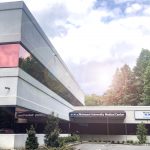Robotic Surgery Procedures in Staten Island, NY
Robotic surgery systems augment the abilities of surgeons, allowing them to work more precisely and effectively. At Richmond University Medical Center on Staten Island, NY, we take advantage of this innovative technique to offer more types of surgical procedures than are otherwise possible. Thanks to the versatility of the da Vinci robotic surgical system, our surgeons can safely and more effectively treat a broad range of conditions.
Robotic Procedures We Perform
At Richmond University Medical Center, over 80 percent of our surgeons have robotic training. This is because we believe in the advantages robotic surgery has for patients, including less pain, reduced complications, and faster recovery. We perform our robotic procedures using the da Vinci Xi, part of the most widely used robotic surgery system in the world. Using this versatile system, our experienced robotic surgery team can effectively address a range of conditions by performing various procedures. These include:
Bariatric (Weight Loss) Procedures
- Sleeve gastrectomy: During a sleeve gastrectomy, a portion of the stomach is surgically removed. Typically, about 70 to 80 percent of the stomach is taken out, leaving behind a narrow, tube-shaped stomach. The size of the stomach is reduced to restrict the amount of food a person can eat at one time.
- Gastric bypass: This is a very common bariatric procedure in which surgeons shrink the size of the stomach and reroute the digestive tract. This helps restrict the amount of food the stomach can hold and prevents the body from absorbing as much food as it used to.
Thoracic Procedures
Robotic systems can be used to perform a variety of procedures relating to the thoracic cavity, or the chest area between the neck and abdomen. These include:
- Chest wall: These procedures diagnose or repair conditions involving the chest muscles, cartilage, and ribs
- Excision of tumors of the lung: This involves the removal of both benign and malignant tumors through one of the following methods:
- Pulmonary lobectomy: This involves the removal of an anatomic lobe of the lung and is the most common definitive treatment for lung cancer.
- Wedge resection: A wedge-shaped section of the lung is removed along with the complete removal of a tumor.
- Segmentectomy: Also known as segmental resection surgery, this procedure involves the removal of an anatomic portion of the lung, larger than a wedge section but smaller than a complete lobe, to achieve complete removal of a tumor.
- Esophageal reflux surgery: Acid reflux happens when contents from your stomach move up into your esophagus. Surgery is performed to tighten and reinforce the lower esophageal sphincter (LES) to prevent this and its long-term effects.
- Esophagomyotomy: This is used to treat achalasia, a condition that makes swallowing difficult due to poor esophageal motility and increased muscle at the terminal end of the esophagus. The procedure involves cutting the esophageal sphincter muscle and then wrapping the upper stomach around this area.
- Excision of tumors of the esophagus: This involves the removal of both benign and malignant tumors on the esophagus.
- Excision of tumors in the mid-chest (mediastinum): This involves the removal of tumors/cysts of the thymus gland, sac around the heart (pericardium), or intercostal nerve sheaths.
- Diaphragmatic plication: This is a procedure used to surgically treat diaphragmatic eventrations or paralysis causing difficulty breathing. It involves repositioning or reshaping the diaphragm to expand lung capacity and improve normal breathing function.
Hernia Treatment Procedures
Through robotic surgery, we treat the following types of hernias:
- Hiatal: This is a condition in which the upper part of the stomach bulges through an opening in your diaphragm.
- Abdominal: This occurs when part of an organ or tissue bulges through a weak spot in the wall of muscle that surrounds your abdomen.
- Inguinal: Occurring in the abdomen near the groin area, this develops when fatty or intestinal tissues push through a weakness in the abdominal wall.
- Ventral: This is a bulge of tissues through an opening in the abdominal wall muscles. It can occur at any location in your abdominal wall, including healed sites of past surgical incisions.
Gynecological Procedures
Robotic surgery techniques can be helpful to address certain gynecology conditions and treat them less invasively, with procedures like:
- Supracervical hysterectomy: Only the uterus is removed, the cervix and fallopian tubes remain in place.
- Abdominal sacral colpopexy: Mesh is surgically inserted to hold the vagina in the correct anatomical position.
- Bilateral salpingectomy: This is the surgical removal of one or both fallopian tubes. The procedure can also include the removal of the ovaries, called an oophorectomy.
Urological Procedures
Certain urological surgeries can use robotic systems to enhance accuracy and reduce pain and healing time, including a prostatectomy. This encompasses the partial or complete removal of the prostate.
Colorectal Procedures
- Colectomy: This is the partial or complete removal of the colon, usually due to cancer.
- Low anterior resection (LAR): This surgery is performed on the upper rectum to remove the cancerous section and connect the colon with the remaining healthy part of the rectum.
- Abdominoperineal resection (APR): This involves the partial or complete removal of the sphincter, which is responsible for bowel control. An APR is performed if cancer is detected too close to the sphincter.
If your doctor has mentioned any of the above procedures to you, ask them if robotic surgery is an option.
Consider Robotic Surgery to Find Relief
If you are looking for an innovative method with a faster recovery time for your next procedure, ask your surgeon about robotic surgery procedures. Richmond University Medical Center offers both robotic surgery procedures and traditional surgery methods to our patients on Staten Island, NY. For more information on robotic surgical procedures, make an appointment today or contact our Department of Surgery at 718-818-2420.



